Bulletin – December 2016 Payments The Future of Cash
- Download 470KB
Abstract
Australian consumers have increasingly been using electronic payment methods in preference to cash for their transactions. The overall demand for cash in Australia, however, remains strong. There is ongoing demand for cash for non-transaction purposes, particularly as a store of wealth. While the role of cash in society is evolving, it is likely to remain an important feature of the payments system and economy for the foreseeable future. Moreover, the current mix of banknote denominations continues to meet community demand for a secure means of payment and store of wealth. Given the ongoing importance of cash, the Reserve Bank will maintain the public's confidence in Australia's banknotes by continuing to ensure that banknotes are of high quality and secure from counterfeiting.
Introduction
Cash continues to play an important role in the Australian economy. Survey data indicate that cash accounted for 47 per cent of consumer payments (by number) in 2013 – still the most frequently used form of payment. This is nevertheless a decline from 2007 when cash accounted for 69 per cent of consumer payments (Graph 1).[1] A shift away from cash – and other paper-based payment methods – towards cards and other electronic means of payment has also occurred in many other advanced economies.[2] Even though the use of cash for transactions has been declining, the overall demand for cash more broadly remains strong, with the ratio of currency (which includes both banknotes and coins) to GDP rising over recent years in Australia and abroad.
The Reserve Bank produces and issues Australia's banknotes to meet public demand, while the distribution of banknotes to commercial banks, other deposit-taking institutions and retailers is undertaken by the private sector.[3] The Reserve Bank also ensures the quality of Australian banknotes by withdrawing old, worn banknotes from circulation and replacing them with new ones. The Reserve Bank conducts research and development to help Australian banknotes remain secure against counterfeiting and has recently issued a new $5 banknote as part of a multi-year upgrade program to introduce a range of new banknote security features.[4]
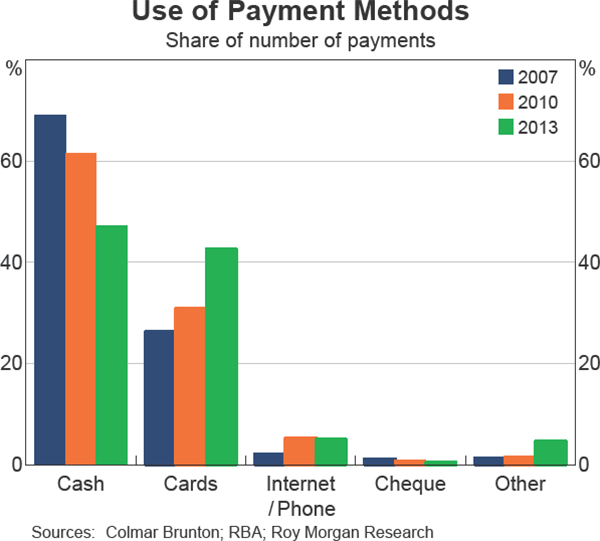
This article discusses the roles and use of cash in the Australian economy in the context of recent trends in the payments mix and the international debate about the future of banknotes. It discusses sources of demand for cash and some policy issues that might arise if the role of cash in the economy declines.
Trends in Cash Demand
There are currently around 1.5 billion Australian banknotes in circulation, worth $73 billion (Table 1). The higher-denomination banknotes – $50 and $100 banknotes – account for around two-thirds of the number of banknotes in circulation, with demand for these two denominations growing at a faster rate than that of the lower denominations in recent years (Graph 2).[5]
The overall demand for cash – as approximated by the total value of banknotes in circulation – increased by 6 per cent over the year to November 2016, which is around its trend pace of the past few years. The value of currency in circulation has increased at a faster rate than nominal GDP in recent years and the currency-to-GDP ratio has risen to its highest level in several decades. Similar trends in currency demand have been evident in many other advanced economies (Graph 3). In the United States, for example, the value of currency in circulation is at its highest level, relative to GDP, since the 1950s.
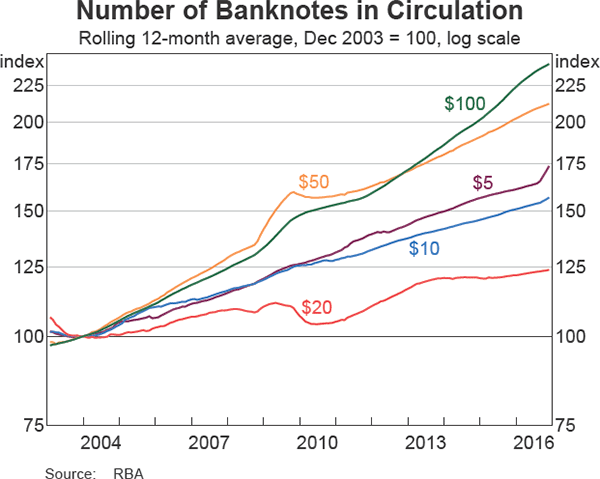
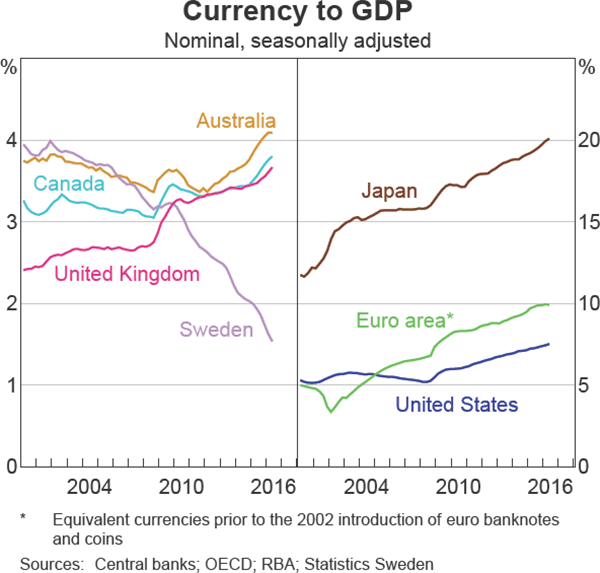
| $5 | $10 | $20 | $50 | $100 | Total | |
|---|---|---|---|---|---|---|
| Value ($b) | 1.0 | 1.3 | 3.3 | 33.5 | 33.9 | 73.0 |
| Share (per cent) | 1 | 2 | 5 | 46 | 46 | |
| Volume (M) | 205 | 128 | 165 | 670 | 339 | 1,507 |
| Share (per cent) | 14 | 9 | 11 | 44 | 22 | |
|
(a) Includes banknotes held by banks, excludes RBA stocks Source: RBA |
||||||
A notable exception to this trend is Sweden, where the stock of currency has declined and the ratio of currency to GDP has fallen from around 4 per cent in the early 2000s to a little over 1½ per cent in 2016. This appears to reflect a decline in both transactional and store-of-value demand for cash in Sweden (Segendorf and Wretman 2015). Australia's currency-to-GDP ratio is currently broadly similar to that in the United Kingdom and Canada, but noticeably lower than the equivalent ratios in the economies of the major global reserve currencies, namely the United States, the euro area and Japan.
Demand for cash in the economy stems from its roles as a means of payment and a store of value. As a means of payment, cash has a number of attributes that may be valued by end users. It has near-universal acceptance, facilitates simultaneous exchange and instantaneous settlement, is convenient for person-to-person payments and can still be used at times when electronic payment methods are unavailable due to internet or electricity outages. Cash transactions are also anonymous and, with low rates of counterfeiting in Australia, fraud may be less of a concern than when using alternative payments. There are, however, a number of less desirable attributes of cash. It can be inconvenient for large transactions, both because it is somewhat bulky to carry and because of the security risk associated with large amounts of cash, and cannot be used for online transactions.
Cash can also be used as a store of value and, for this purpose, its attributes come to the fore in times of economic/financial uncertainty. In particular, in circumstances in which the viability of banks is under question – as was the case in many countries during the 2008–09 financial crisis – cash may be considered a superior store of value to money held in the form of bank deposits. That is, claims on the central bank are preferred to claims on a commercial bank. However, the strengthening of depositor protection arrangements in Australia, as well as storage and security challenges associated with large cash holdings, may offset any such considerations. The value of cash holdings will also be eroded over time by inflation, although this effect is considerably lower in the current low inflation/low interest rate environment.
Transactional Demand for Cash
The most recent detailed data on the use of cash for consumer payments in Australia are from the Reserve Bank's 2013 Survey of Consumers' Use of Payment Methods (Consumer Use Survey).[6] In the 2013 survey, cash was still the most frequently used payment method for consumer transactions, although its use had been declining relative to other payment methods, particularly electronic ones, for a number of years (Graph 1).[7] Cash is used more often for smaller transactions, with participants in the 2013 survey using cash to make 69 per cent of payments (by number) worth $20 or less. But even for low-value transactions, consumers are shifting to electronic alternatives, most notably contactless cards (Ossolinski, Lam and Emery 2014). By value, cash accounted for 18 per cent of transactions in 2013, compared with 38 per cent in 2007. Since 2013, there has been a sustained decline in ATM and point-of-sale debit card cash withdrawals, which is consistent with a reduction in cash use in transactions (Graph 4).
Australian consumers are not alone in shifting away from cash for transaction purposes, although there are some notable differences in cash use across countries. Several advanced countries conduct studies of payment patterns similar to the Reserve Bank's Consumer Use Survey. Although the survey results are not fully comparable, some broad observations can be made:
- Consumers are shifting away from cash transactions globally, with relative cash use for transaction purposes having fallen in all countries for which data are readily available (Table 2).
- Cash remains the dominant means of payment in some European economies; for example, around 80 per cent of consumer transactions in Germany and Austria are conducted in cash.
- Australian consumers use cash in a roughly similar share of transactions (around half ) as Canadian, Dutch and UK consumers, according to each country's most recent survey.
- Swedish consumers use cash relatively infrequently as a means of payment (in less than one-fifth of transactions).
- Because it is most often used for low-value transactions, cash makes up a much smaller share of the payment mix in most countries when measured by value.
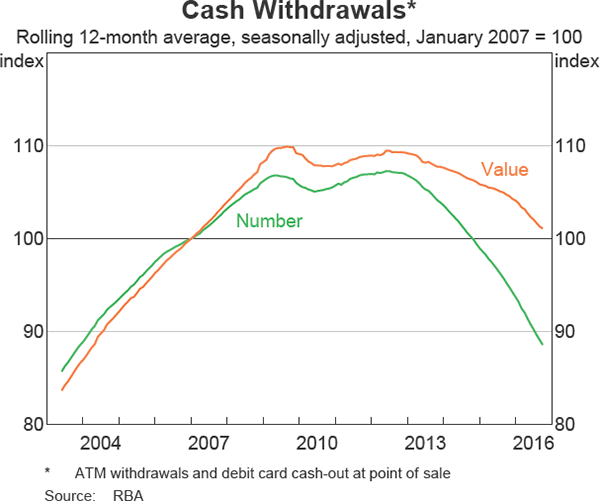
| Country | Most recent estimate | Year | Previous estimate | Year | ||
|---|---|---|---|---|---|---|
| Share of transactions (per cent) | Share of transactions (per cent) | |||||
| By number | By value | By number | By value | |||
| Australia | 47 | 18 | 2013 | 62 | 29 | 2010 |
| Austria | 83 | 68 | 2011 | 86 | 70 | 2005 |
| Canada | 44 | 23 | 2013 | 54 | 23 | 2009 |
| France | 58 | 2011 | 64 | 2005 | ||
| Germany | 79 | 53 | 2014 | 82 | 53 | 2011 |
| Netherlands | 50 | 30 | 2015 | 65 | 38 | 2010 |
| Sweden | 15 | 2016 | 39 | 2010 | ||
| UK | 45 | 2015 | 64 | 2005 | ||
| US | 32 | 9 | 2015 | 40 | 14 | 2012 |
|
(a) Estimates are not fully comparable across countries due to different collection methods and inclusions – the US and UK estimates, for example, include recurring bill payments, which are not included in all countries' estimates; most countries' estimates are based on survey respondents' payment diaries kept over 1–8 days; estimates for Sweden and the UK use other methods Sources: National sources; RBA |
||||||
Research indicates that cash use in Australia, and elsewhere, is associated with particular types of transactions and consumer characteristics. For example, cash is used more frequently for lower-value transactions, cash use tends to decrease with higher levels of education and income and cash tends to be used more frequently by older generations (Graph 5).[8] However, consumer preferences also seem to play an important role. In Germany, for example, there is a clear preference for cash that cannot be explained by other factors (Schmidt 2016).
Despite greater use of electronic payment methods, survey evidence suggests that consumers continue to use cash at the point of sale for a number of reasons. These include non-acceptance of cards for small transactions, a desire to avoid card surcharges at some merchants, the speed or ease of completing a transaction (although this may be changing with the growth of contactless cards) and a preference for using one's own funds to help with budget management (Meredith et al 2014).
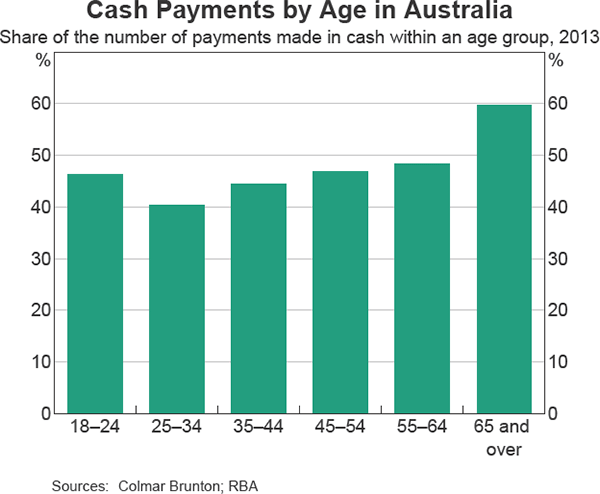
It is likely that the share of total consumer payments conducted with cash will continue to decline – though not necessarily for all consumers – as the range of alternatives to cash expands and electronic payment methods are increasingly adopted, including for low-value transactions. The rapid uptake of contactless card payments, for example, indicates that many consumers have been willing to substitute away from cash for low-value payments when an electronic alternative could match cash for speed at the checkout. Mobile phone payments offer another potentially convenient alternative to cash at the point of sale and it would not be surprising to see strong growth in this method of payment, although the substitution here may partly be away from physical cards rather than cash. The New Payments Platform (NPP), which is due to be launched in late 2017, will provide an electronic alternative to cash in some circumstances where there are currently few convenient non-cash options.[9] Whereas substitutes for cash already exist for most types of consumer transactions, the NPP will offer a genuine alternative to cash in other situations, such as person-to-person transfers and payments to small businesses.[10] Broader social and demographic trends may also influence the future payments mix, as generations with a higher propensity to use electronic payment methods account for a larger share of the population.
A related issue that has been widely debated in recent years is the potential for digital currencies to displace cash. As noted by Richards (2016), however, it seems improbable that privately established virtual currencies will displace the use of national currencies within individual economies. While a number of central banks have announced that they are exploring issues pertaining to state-issued digital currency, most commentary indicates that this issue will be approached cautiously and that there are no plans to phase out cash.[11]
Overall, cash is expected to remain an important part of the payment system for the foreseeable future. Some people may still have few alternatives to cash that are readily available or accepted by merchants. And some members of the community are likely to continue to prefer to use cash for reasons that may not necessarily be influenced by the availability of alternatives.
Other Sources of Cash Demand
Trends in cash demand across a range of countries cannot be easily reconciled with changes in consumer payment preferences. The implication is that there is ongoing demand for cash for purposes other than domestic consumer transactions, including as a store of value in the domestic economy. Foreign demand and the use of cash for unlawful purposes – both of which may derive from transactional or store of value motives – are other potential sources of cash demand. As holdings and use of cash are anonymous, however, it is not possible to accurately measure these various sources of demand.
Domestic store of value
Even though the share of cash transactions is declining, cash is still held as a store of wealth, including for precautionary purposes. In Australia, around three-quarters of respondents to the 2013 Consumer Use Survey reported that they held cash in places other than in their ‘wallets’, with the most important reason – other than for day-to-day transactions – being to fund emergency transactions. Other reasons related to the costs of accessing cash, including the time and cost of making withdrawals and access to ATMs (Graph 6). It is difficult to predict how demand for cash as a store of value may evolve in the future, partly because ‘hoarding’ behaviour is probably influenced by personal preference, particularly for those holding large sums of cash. It is, however, possible that future technological advances could play a role. For example, at some point in the future, digital currencies might provide a viable alternative to cash holdings for some people, including those who value privacy and anonymity.
Macroeconomic factors are likely to have also contributed to recent strong demand for cash as a store of value, with low global and domestic interest rates reducing the opportunity cost of holding cash over other assets.[12] Although interest rates around the world are expected to remain low for some time, any significant rise in rates will increase the opportunity cost of holding cash and demand for cash may gradually diminish over time. There is also evidence that the global financial crisis contributed to demand for cash for precautionary purposes, with year-ended growth in the number of $100 Australian banknotes in circulation – the denomination most often used as a store of value – rising sharply in 2008 (Graph 7). Similar spikes in demand for high-denomination banknotes were observed in other countries during the crisis.
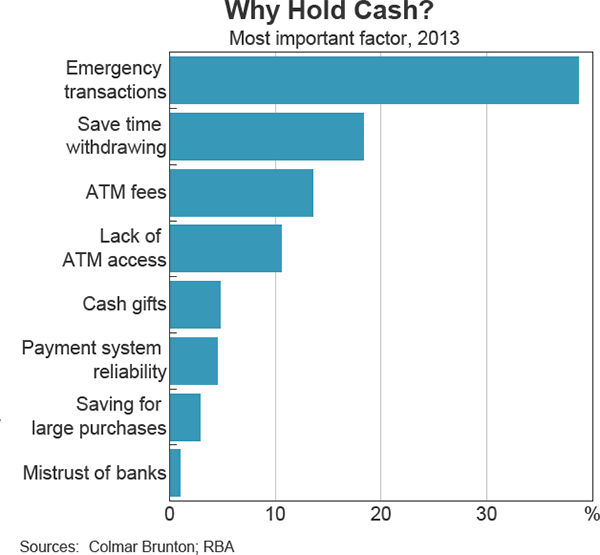
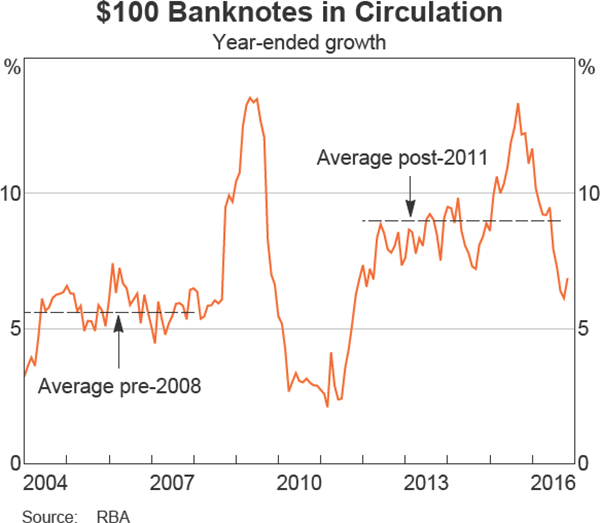
Foreign demand
Foreign citizens may wish to hold cash issued in another economy, either for transactional purposes or as a store of value. For some countries, offshore demand is likely to be an important contributor to the overall demand for their currency. The Federal Reserve estimates that one-half to two-thirds of US currency in circulation is held abroad (Federal Reserve 2016). Similarly, the Bank of England estimates that ‘no more than half’ of the stock of sterling banknotes in circulation is legitimately held within the United Kingdom (Fish and Whymark 2015) and the European Central Bank (ECB) has suggested that at least 18 per cent of euros on issue were held outside of the euro area in 2014 (ECB 2015).
While there are no reliable data available on foreign holdings of Australian banknotes, there is evidence to suggest that offshore demand has increased in recent years, with movements in the exchange rate influencing short-term foreign demand for Australian banknotes. The sharp depreciation of the Australian dollar during the global financial crisis, for example, coincided with a spike in demand for Australian $100 banknotes (Graph 8). Further, liaison with major cash industry participants indicates that increases in overseas demand are a fairly usual occurrence when the Australian dollar depreciates. Part of this demand is likely to stem from the increased attractiveness of Australia as a destination for tourism and education, with both of these groups of visitors tending to be large users of cash.

Shadow economy and high-denomination banknotes
A potential source of currency demand that has attracted international attention recently is the use of cash, particularly high-denomination banknotes, to avoid reporting income to the authorities, or to finance illicit activities. Cash may be valued by those engaged in such activities because it is anonymous and untraceable. By definition, however, this also means that it is not possible to assess the demand for cash for these purposes accurately.[13] Some commentators have nonetheless argued that strong demand for cash globally reflects, to a significant extent, the use of cash for unlawful purposes.[14]
Internationally, there have been some moves to change the mix of banknote denominations, aimed at making it more difficult to use cash for nefarious purposes. Most prominently, the ECB announced in May 2016 that it would end production and issuance of its EUR 500 (AUD 711) banknote around the end of 2018. The ECB will, however, continue to issue EUR 200 banknotes (AUD 285).[15] Another example is the recent announcement by the Indian Government that the existing 500 rupee (AUD 10) and 1,000 rupee (AUD 20) banknotes would cease to be legal tender, to address problems with counterfeiting and ‘black money’ (income earnt illegally or not declared for tax purposes). The Indian Government is, however, issuing a new series of 500 rupee banknotes, and is introducing a 2,000 rupee (AUD 39) banknote.
In an international context, Australia's banknotes are not available in unusually large denominations. The value of the AUD 100 banknote, our highest denomination, is similar to national equivalents in a range of advanced economies (Table 3).[16]
Contrary to some claims, high-denomination Australian banknotes are used in a non-negligible proportion of legitimate transactions. For example, sampling by the Reserve Bank suggests that $100 banknotes account for up to 5 per cent of the cash banked by retailers and supermarkets, and 10 per cent for post offices, likely reflecting the payment of some household bills (Graph 9). While these figures do not represent the chance of a particular denomination being used in any given transaction, they indicate continued transactional use of the $100 banknote at a range of retailers.
| US | New Zealand | Canada | Euro area(a) | Switzerland | Japan | UK | |
|---|---|---|---|---|---|---|---|
| Local currency | 100 | 100 | 100 | 500 | 1,000 | 10,000 | 50 |
| AUD equivalent(b) | 134 | 96 | 100 | 711 | 1,321 | 119 | 84 |
|
(a) The ECB has announced its intention to stop producing EUR 500 banknotes
in 2018, the EUR 200 banknote (AUD 285) will become the highest remaining
denomination Sources: Central banks, RBA, Thomson Reuters |
|||||||
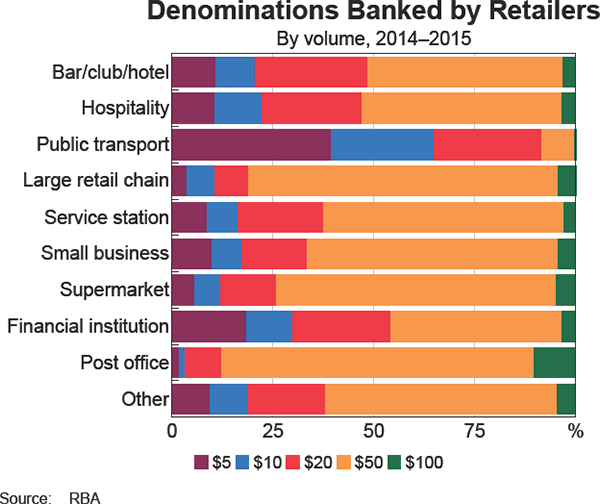
As noted, it is not possible to estimate the extent to which cash, or any particular banknote denomination, is used in illegal activities. However, liaison with AUSTRAC (Australian Transaction Reports and Analysis Centre) and the Australian Crime Commission suggests that it is the $50 denomination – rather than the $100 – that tends to be preferred by criminal elements because of its ubiquitous use in legitimate transactions. This suggests that to the extent that the $100 banknote is being used for nefarious purposes, any phase-out may not be particularly disruptive to those engaged in such activities.
Any deliberation on the future denominational mix of Australian banknotes should also consider the potential costs of phasing out a particular denomination. In the case of $100 banknotes, this would include the welfare reduction associated with the loss of these banknotes for legitimate transactions and as a store of wealth. Another potentially significant cost would be higher printing and distribution costs if consumers and businesses shifted to using lower-denomination banknotes. An assessment of the case for phasing out $100 banknotes would also need to consider the issue in the context of a broader range of policy measures that could potentially be taken to deter activities such as tax avoidance and crime.[17]
Costs of Cash Use
One argument that is sometimes made in support of phasing out cash is that it is a costly payment instrument relative to the electronic alternatives. Data from the Reserve Bank's latest Payment Costs Study, however, indicated that the direct resource costs incurred by financial institutions and merchants in accepting an average-sized payment in cash from households were relatively low compared with some other payment methods (Graph 10).[18] The study estimated that, in 2013, cash would have been the lowest-cost payment method for just under half of consumer payments (based on transaction size), although this share had fallen from around three-quarters when estimated at the time of the previous costs study in 2006.[19]

It was, however, estimated that the average resource costs of cash had increased between the two payment costs studies: from 37 cents per transaction in 2006 to 48 cents per transaction in 2013. This increase was largely attributed to higher average per-transaction costs incurred by financial institutions and merchants in the course of distributing cash; for example, bank branch staffing and location rental costs were spread over fewer branch withdrawals.
If the decline in cash use continues, all else being equal, the average per-transaction cost of cash payments is likely to continue to increase, both in absolute terms and relative to other payment methods. That is, the fixed costs associated with storing, transporting and distributing cash in a country the size of Australia would be spread over fewer transactions. Over time, this dynamic may raise issues around the supply of cash services across the country if private sector participants were to become disinclined to offer such services, or to do so at a much higher cost to consumers. This appears to have been the case in Sweden, where the speed at which private financial institutions have cut back on the provision of cash services has become a policy concern, and the official sector has considered measures to ensure that these services remain readily available (Sveriges Riksbank 2016).
A particular consideration in this context would be to ensure that cash is accessible to all those who need and wish to use it, including segments of society that are particularly reliant on cash. The 2013 Consumer Use Survey showed that there is a small but significant share of the Australian population that relies heavily on cash, with around 10 per cent of respondents making all their in-person payments with cash. While the Reserve Bank's current cash distribution arrangements – which as noted above are undertaken by the private sector – are working well, the Reserve Bank will continue to monitor cash distribution throughout the economy to ensure that it continues to meet the needs of the community.
Conclusion
The share of cash-based transactions in the economy has declined. This trend is likely to continue with the growing adoption of mobile payments and the commencement of the NPP, which will offer further alternatives to cash. Nevertheless, it is likely that cash will continue to be used extensively by certain groups of consumers and in particular types of transactions, and cash will remain an important part of the Australian economy and the payments system for the foreseeable future. It will also continue to be valued as a store of wealth.
As the role of cash evolves, the Reserve Bank will continue to consider how best to meet the demand for banknotes, in order to ensure that cash is readily available to those who wish to use it. In this regard, ensuring appropriate access to cash for citizens who have few alternatives is likely to be a priority. Over a longer horizon, there will be attention globally on the potential for new technologies to influence the way in which central banks meet society's demand for currency.
Footnotes
Samual Nightingale and Cassie Davies are from Note Issue Department; Chay Fisher and Mary-Alice Doyle are from Payments Policy Department. The authors thank Gordon Flannigan for assistance. [*]
The Reserve Bank has conducted a survey of consumer payments every three years since 2007 and is in the process of undertaking the 2016 survey. See Emery, West and Massey (2008); Bagnall, Chong and Smith (2011); and Ossolinski, Lam and Emery (2014). [1]
See also Richards (2016) for a detailed discussion of the cheque system. [2]
For further information on banknote distribution arrangements, see Cowling and Howlett (2012). [3]
See Fox, Liu and Martz (2016) for further detail on the development and issuance of the new banknote series. [4]
Banknotes account for most of the value of currency in circulation, with coins making up around 5 per cent of the total. [5]
Note that while the majority of cash transactions are made by consumers, cash is also used in some business-to-business payments. The available data do not provide information on these types of payments. [6]
For previous analyses of the use of cash based on the Reserve Bank's consumer use surveys, see Bagnall and Flood (2011) and Meredith, Kenney and Hatzvi (2014). [7]
Bagnall, Bounie, Huynh, Kosse, Schmidt, Schuh and Stix (2014) suggest that cross-country differences in cash use may also be associated with variation in factors such as merchant acceptance, market structure and pricing policies for retail payments. See also Meredith et al (2014), who found that education was not an important factor in determining cash use in Australia after controlling for other factors. [8]
The NPP will allow individuals and businesses to make account-to-account funds transfers in real time, at any time of the day or night, seven days a week. [9]
In Sweden, for instance, use of the real-time mobile payments app Swish has grown rapidly since the launch of real-time payments in 2012. By 2016, just over half of the respondents to a Riksbank survey had used Swish in the past month, compared with 10 per cent in 2014. Overall it was used for around 2 per cent of transactions. [10]
See, for example, Broadbent (2016) and Skingsley (2016). [11]
Cusbert and Rohling (2013) find evidence that non-bank demand for currency holdings in Australia is negatively correlated with changes in deposit rates. In Japan, an increase in non-transactional demand for cash may be partly attributable to persistent low interest rates (Otani and Suzuki 2008). [12]
The Australian Bureau of Statistics (ABS) estimated that in Australia the underground economy (that is, activity that may be legal, but is concealed from public authorities) accounted for around 1½ per cent of total GDP in 2010/11, which is significantly smaller than the estimates from cross-country studies that are sometimes referred to in this context (ABS 2013). [13]
See Sands (2016), Summers (2016), and Rogoff (2016) among others. [14]
Exchange rates as at end November 2016. [15]
In addition, the real value of the AUD 100 banknote has declined significantly over time. Since the AUD 100 banknote was first issued in 1984 consumer prices have increased by around 200 per cent. [16]
For example, in some countries cash registers must be certified so that information on transactions can be audited. [17]
The resource cost is a measure of how much it costs the economy to ‘produce’ a payment. For more information on the costs of payment methods, see Schwartz et al (2008) and Stewart et al (2014). [18]
These estimates combine information from the consumer use surveys and payment costs studies. In 2007, the median consumer transaction value was $20, while cash was the method with the lowest average cost for transactions under $60. In 2013, the median transaction amount was $23, with cash having the lowest average cost for transactions under $20. [19]
References
ABS (Australian Bureau of Statistics) (2013), ‘Information Paper: The Non-Observed Economy and Australia's GDP, 2012’, ABS Cat No 5204.0.55.008, September.
Bagnall J, S Chong and K Smith (2011), ‘Strategic Review of Innovation in the Payments System: Results of the Reserve Bank of Australia's 2010 Consumer Payments Use Survey’, Reserve Bank of Australia, June.
Bagnall J and D Flood (2011), ‘Cash Use in Australia: New Survey Evidence‘, RBA Bulletin, September, pp 55–62.
Bagnall J, D Bounie, K Huynh, A Kosse, T Schmidt, S Schuh and H Stix (2014), ‘Consumer Cash Usage: A Cross-Country Comparison with Payment Diary Survey Data’, ECB Working Paper No 1685.
Broadbent B (2016), ‘Central Banks and Digital Currencies’, Speech at London School of Economics, London, 2 March.
Cowling A and M Howlett (2012), ‘Banknote Quality in Australia’, RBA Bulletin, June, pp 69–75.
Cusbert T and T Rohling (2013), ‘Currency Demand during the Global Financial Crisis: Evidence from Australia’, RBA Research Discussion Paper No 2013-01.
European Central Bank (2015), ‘The International Role of the Euro’, July.
Emery D, T West and D Massey (2008), ‘Household Payment Patterns in Australia’, in Payments System Review Conference, Proceedings of a Conference, Reserve Bank of Australia, Sydney, pp 139–176.
Federal Reserve (2016), ‘Currency and Coin Services’, available at <https://www.federalreserve.gov/paymentsystems/coin_about.htm>.
Fish T and R Whymark (2015), ‘How Has Cash Usage Evolved in Recent Decades? What Might Drive Demand in the Future?’, Bank of England Quarterly Bulletin, Q3, pp 1–12.
Fox P, C Liu and A Martz (2016), ‘New Banknotes: From Concept to Circulation’, RBA Bulletin, September, pp 1–11.
Meredith J, R Kenney and E Hatzvi (2014), ‘Cash Use in Australia’, RBA Bulletin, June, pp 43–54.
Ossolinski C, T Lam and D Emery (2014), ‘The Changing Way We Pay: Trends in Consumer Payments’, RBA Research Discussion Paper No 2014-05.
Otani A and T Suzuki (2008), ‘Background to the High Level of Banknotes in Circulation and Demand Deposits’, Bank of Japan Review, 2008-E-5.
Richards T (2016), ‘The Ongoing Evolution of the Australian Payments System’, Speech at Payments Innovation 2016 Conference, Sydney, 23 February.
Rogoff K (2016), The Curse of Cash, Princeton University Press, New Jersey.
Sands P (2016), ‘Making it Harder for the Bad Guys: The Case for Eliminating High Denomination Notes’, Mossavar-Rahmani Center for Business and Government Associate Working Paper No 52.
Schmidt T (2016), ‘Cash Payments More Popular in Germany than in Other Countries’, Deutsche Bundesbank Research Brief, February.
Schwartz C, J Fabo, O Bailey and L Carter (2008), ‘Payment Costs in Australia’, in Payments System Review Conference, Proceedings of a Conference, Reserve Bank of Australia, Sydney, pp 88–138.
Segendorf B and A-L Wretman (2015), ‘The Swedish Payment Market in Transformation’, Sveriges Riksbank Economic Review, Volume 3, pp 48–68.
Skingsley C (2016), ‘Should the Riksbank Issue E-Krona’, Speech at FinTech Stockholm 2016, Berns, 16 November.
Stewart C, I Chan, C Ossolinski, D Halperin and P Ryan (2014), ‘The Evolution of Payment Costs in Australia’, RBA Research Discussion Paper No 2014-14.
Summers L (2016), ‘It's Time to Kill the $100 Bill’, Washington Post, 16 February. Available at <https://www.washingtonpost.com/news/wonk/wp/2016/02/16/its-time-to-kill-the-100-bill>.
Sveriges Riksbank (2016), ‘Introduce a Legal Requirement for the Banks’ Cash Service’, Media release, 16 March.